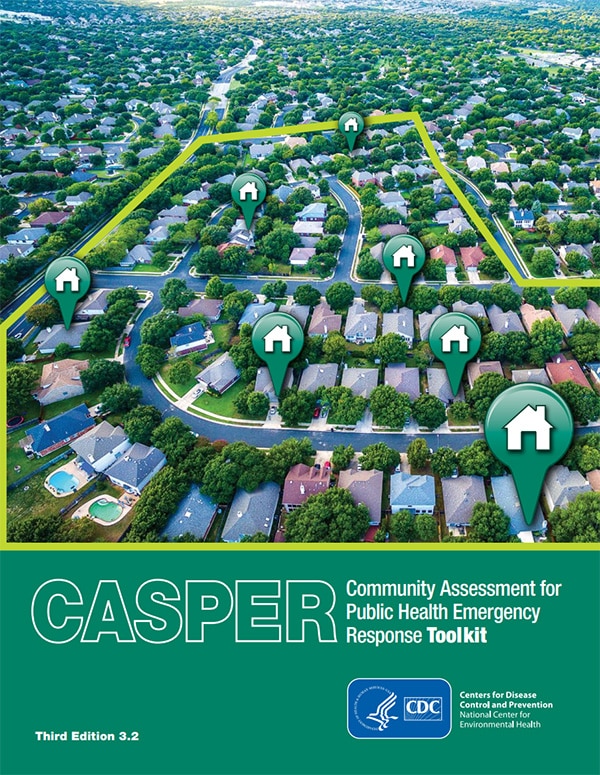Overview of CASPER

The Community Assessment for Public Health Emergency Response (CASPER) is designed to provide public health leaders and emergency managers information about a community so they can make informed decisions. CASPER is quick, relatively inexpensive, flexible, and uses a simple reporting format. It uses a valid sampling methodology to collect information at the household level and can be used in disaster or non-disaster settings.
What is CASPER?
CASPER is a type of Rapid Needs Assessment (RNA) that provides household-level information to public health leaders and emergency managers. The information generated can be used to initiate public health action, identify information gaps; facilitate disaster planning, response, and recovery activities; allocate resources, and assess new or changing needs in the community. It is a cross-sectional epidemiologic design; it is not surveillance.
The CASPER methodology is an adaptation of epidemiologic techniques used by scientists in the World Health Organization’s (WHO’s) Expanded Program on Immunization (EPI) to estimate vaccine coverage in Africa.
The cluster sampling design used for CASPER involves two-stages (30 clusters selected probability proportional to size and seven households interviewed within each cluster) and provides estimates for the population.
How can CASPER be used?
There are many opportunities for CASPERs to influence public health. A CASPER can be used in both a disaster and non-disaster setting.
For example, CASPER methodology has been used to do the following:
- Assess public health perceptions
- Estimate needs of a community
- Assist in planning for emergency response
- As part of the public health accreditation process
Regardless of the setting and objectives, once the decision to conduct a CASPER has been made, it should be initiated as soon as possible. See the Interactive Map for examples of how CASPER has been used throughout the United States since 2001.
What is in the CASPER toolkit?
In the early 2000s, the two-stage cluster method became an increasingly widespread method for disaster response. Because of this, the Centers for Disease Control and Prevention (CDC) developed the CASPER Toolkit pdf icon[PDF – 17 MB] to outline and standardize the assessment methodology. As part of this process, CDC coined the term CASPER to distinguish it from, and avoid confusion with, other rapid needs assessments.
The CASPER toolkit provides guidelines to assist personnel from any federal, state, tribal, local, or territorial (STLT) public health departments or other emergency response agencies in conducting CASPER. It is intended to assist those in conducting a CASPER by providing a standardized, step-by-step guide and includes the following:
- Preparing checklist
- Questionnaire development
- Sample selection
- Training
- Data collection
- Analysis
- Report writing
- Templates and examples
Public health personnel, emergency management officials, academics, or others who wish to assess household-level public health needs will find the toolkit useful for rapid data collection for actionable decision making during disaster or non-emergency situations.
Why is this information important? What is the benefit of CASPER?
Information is key for decision-making. Information sent to the right people, at the right place, at the right time, is optimal for any successful response. CASPER addresses this by providing valid information rapidly about the general and health needs of a community to decision-makers. CASPER is generalizable (providing population estimates), timely, relatively low cost, reported in a simple format, and flexible.
While CASPER was originally designed to provide information during a disaster response, it can also be used when population-representative data are needed during other disaster phases (preparedness, recovery, mitigation) and in situations unrelated to a disaster. For example, public health departments have used CASPER to do the following:
- Identify household-level information about community health status
- Learn more about emerging infectious diseases such as Zika virus and H1N1
- Assess community awareness, opinions, and concerns on subjects such as opioid use, e-cigarettes, coal gasification plants, healthy homes, and radiation emergency preparedness
How are data used?
Data are used to provide situational awareness, confirm (or contradict) rumors or anecdotal reports, identify and provide estimates of needs in the community (e.g., food, water, medication), establish priorities, and tailor interventions and communication messaging. Other potential benefits include the following:
- Monitor changes in community needs
- Raise visibility of emergency management and public health in the community
- Justify requests for outside assistance or funding
- Evaluate the effectiveness of response activities
- Serve as field exercise to build capacity and prepare the workforce for emergency situations
CASPER data has been impactful in the past from resource allocation and support for funding of projects or services to targeting messages and future planning. To learn more about previous CASPERs, view the Interactive Map of CASPERs.
What are some considerations prior to conducting a CASPER?
Prior to conducting a CASPER, you should decide if CASPER provides an appropriate sampling methodology based on your objectives, timeframe, and available resources. CASPER uses a two-stage cluster sampling design in which 30 clusters are selected proportional to the number of households in the cluster and then 7 households are selected systematically for interviews for in each of the 30 clusters. A clear understanding of how CASPER information will be used, who the relevant stakeholders are, and needed and available resources is important prior to moving forward with your CASPER. Remember, a CASPER will be descriptive of the entire sampling frame (geographic area from which your sample is drawn); it will not provide detailed information on subpopulations or target specific groups. For example, if your objective is to determine the needs or status of pregnant women or persons experiencing homelessness, you should not conduct a CASPER. For more information, please see CASPER toolkit, Figure 1 pdf icon[PDF – 17 MB] or contact CASPER@cdc.gov.
How do I get started?
Contact CASPER@cdc.gov if you are interested in conducting a CASPER. CDC provides scientific consultation, technical assistance, and disaster epidemiology training to the following organizations:
- State, regional, tribal, local, territorial, or foreign health departments
- Federal agencies
- Non-governmental organizations
- Professional interest groups
- International organizations
- Academic institutions
- Foreign governments
To learn more about requesting assistance or training, please visit the Disaster Epidemiology and Response Team’s Training and Technical Assistance webpage. Additionally, if you would like more information, you can check out the CASPER eLearning for an overview of the CASPER methodology, its uses, and the local capabilities required to conduct a CASPER.
CASPER Phases
There are four phases in a CASPER: prepare for the CASPER, conduct the CASPER in the field, analyze the data, and write the report.
Phase 1: Prepare for CASPER

As you prepare to conduct a CASPER, there are many planning questions that should be addressed. Work with leadership, key stakeholders, and CASPER subject matter experts (SMEs) within your state or CDC to help plan and prepare. Keep in mind that preparing for a CASPER can take several hours (e.g., during a response) or, if time allows, several months (e.g., in a non-disaster setting).
Learn more about how to Prepare for CASPER.
Phase 2: Conduct the CASPER in the Field

CASPER is conducted through face-to-face interviews in the field. There are several advantages to conducting face-to-face interviews; these include a high response rate and the ability to distribute health information or other materials (such as resource lists) to the community. Face-to-face interviews have the additional benefit of directly connecting the community to local staff, increasing the visibility of and trust in the health department. Interview teams can also provide anecdotal information (e.g., direct visual inspection of a disaster-affected area, common concerns overheard in the community not captured in the questionnaire) that can help guide response and recovery efforts, implementation of any recommendations, and future plans.
Learn more about how to conduct the CASPER in the field.
Phases 3 & 4: Analyze and Report CASPER Data

Data from the questionnaire can be entered into any statistical software package that allows for multistage sample design weighting. We recommend using Epi Info™, which is user-friendly, does not require computer permissions for download, and is available free of charge. For tutorials and guidance on Epi Info™, visit https://www.cdc.gov/epiinfo/index.html. Data from the tracking form can be entered into any spreadsheet such as Microsoft Excel.
Disseminating findings is a vital component of a CASPER. Information from the CASPER will help partners better understand the needs and health status of the community.
Learn more about how to analyze and report CASPER data.
